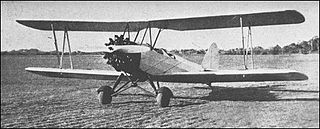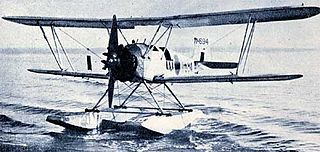Related Research Articles

The Tachikawa Ki-17 was a basic training aircraft of the Imperial Japanese Army Air Force built by Tachikawa Aircraft Company Ltd in the 1930s. It was known to the Allies under the nickname of Cedar during World War II.

The Tachikawa Ki-9 was an intermediate training aircraft of the Imperial Japanese Army Air Force built by Tachikawa Aircraft Company Ltd in the 1930s. It was known to the Allies under the nickname of "Spruce" during World War II.

The Mitsubishi Ki-30 was a Japanese light bomber of World War II. It was a single-engine, mid-wing, cantilever monoplane of stressed-skin construction with a fixed tailwheel undercarriage and a long transparent cockpit canopy. The type had significance in being the first Japanese aircraft to be powered by a modern two-row radial engine. During the war, it was known by the Allies by the name Ann.
Tachikawa Aircraft Company Limited was an aircraft manufacturer in the Empire of Japan, specializing primarily in aircraft for the Imperial Japanese Army Air Force. It was based at Tachikawa, in Tokyo Prefecture.

The Nakajima Ki-4Kyūyon-shiki teisatsuki (九四式偵察機) was the last biplane reconnaissance aircraft of the Japanese Imperial Army. It saw combat service in Manchukuo and in north China during the early stages of the Second Sino-Japanese War.

The Nakajima Ki-11 was an unsuccessful attempt by Nakajima Aircraft Company to meet a 1935 requirement issued by the Japanese government for a modern single-seat monoplane fighter suitable to meet the needs of both the Imperial Japanese Army Air Force and Imperial Japanese Navy Air Service

The Mitsubishi Ki-18 was an unsuccessful and unsolicited attempt by Mitsubishi to meet a 1934 requirement issued by the Japanese Army for a modern single-seat monoplane fighter suitable to the needs of the Imperial Japanese Army Air Force. During this competition, Nakajima entered the Nakajima Ki-11, and Kawasaki entered the more maneuverable Kawasaki Ki-10 biplane. The competition was won by Kawasaki, but the new fighter was not accepted by the IJAAF with much enthusiasm.
The Hitachi TR.1 was a small airliner developed in Japan in 1938, produced in small numbers as the TR.2. It was a low-wing, cantilever monoplane with retractable tailwheel undercarriage and a fully enclosed cabin. The design strongly resembled the Airspeed Envoy that it was intended to replace in Japanese airline service. Testing of the TR.1 prototype commenced on 8 April 1938 at Haneda Airport, but it suffered a serious accident on 22 June due to a landing in which one of the main undercarriage units failed to extend.

The Yokosuka K4Y was a Japanese floatplane trainer of the 1930s. A single engined two-seat biplane, 211 K4Ys were built between 1933 and 1940, serving as the Imperial Japanese Navy's basic floatplane trainer throughout the Second World War.

The Aichi AB-3 was a Japanese ship-board reconnaissance floatplane of the 1930s. The AB-3, a single-seat, single-engined biplane, was designed to equip a light cruiser Ning Hai being built in Japan for the Chinese navy, a single aircraft being accepted by the Chinese.
The Aichi F1A was a prototype Japanese floatplane of the 1930s. A single-engined biplane, the F1A was intended as a short-range observation aircraft suitable for operation off the Imperial Japanese navy's warships, but only two were built, the Mitsubishi F1M being selected instead.

The Mitsubishi 1MF10 or Mitsubishi Experimental 7-Shi Carrier Fighter (七試艦上戦闘機) was a prototype Japanese monoplane single-seat carrier-based fighter aircraft of the 1930s. Two were built for the Imperial Japanese Navy, but both were lost in crashes, with no production following.
The Nakajima D3N was a Japanese carrier-based dive bomber of the 1930s. Three prototypes were built for the Imperial Japanese Navy, but no production followed, with the Aichi D3A being selected instead.
The Yokosuka E6Y was a Japanese submarine-based reconnaissance seaplane developed at the Yokosuka Naval Air Technical Arsenal for the Imperial Japanese Navy during the 1920s. The prototype first flew as the Yokosho 2-Go in 1929.
The Kawanishi K8K was a Japanese floatplane trainer designed and built by the Kawanishi Aircraft Company for the Imperial Japanese Navy. It was selected for production, but only a small number were built before a change in the Japanese Navy's training needs led to production being stopped.
The Watanabe K8W was a Japanese floatplane trainer designed and built by Watanabe for the Imperial Japanese Navy.

The Gasuden Jimpu or Kamikaze was a Japanese seven-cylinder air-cooled radial aircraft engine from the 1920s, 1930s and 1940s. It was the first aircraft engine produced by Tokyo Gas and Electric, often abbreviated to Gasuden, and the first production engine produced in Japan. It was produced in large numbers to power training and light aircraft before and during the Pacific War.
The Tachikawa KKY, full name Tachikawa Army Small and Light Ambulance Aircraft was designed to rescue injured or sick patients from places without established airfields. Following two earlier prototypes, 21 production examples were built between 1936 and 1940 and served in the Second Sino-Japanese War.
The Tokyo Koku Aiba-Tsubame or Tokyo Aviation Aiba-Swallow was a 1930s Japanese civil transport with seats for three passengers. It was intended to be cheap to produce so, although its fuselage was a new design, its wings and undercarriage were those of another Japanese aircraft. Two were built and flew taxi services and joyrides.
The Tokyo Koku Aiba 11 was a 1940s Japanese civil transport aircraft derived from the Tokyo Koku Aiba 10 trainer. Its cabin accommodated three passengers on taxi or sight-seeing flights. Though well-regarded, developing military demands prevented its production.
References
- ↑ Mikesh & Abe 1990, pp. 103, 253
- 1 2 Mikesh & Abe 1990 , pp. 253–254
- 1 2 Mikesh & Abe 1990, p. 254
- ↑ Francillon 1970 , pp. 3
- Francillon, R. J. (1970). Japanese Aircraft of the Pacific War. London: Putnam. ISBN 0-370-00033-1.
- Mikesh, Robert C.; Abe, Shorzoe (1990). Japanese Aircraft 1910–1941. London: Putnam. ISBN 0-85177-840-2.